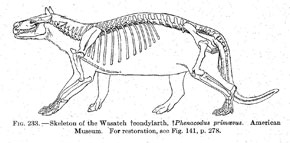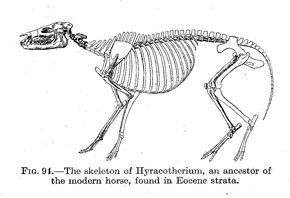Evolution
Introduction
Perissodactyls include tapirs, rhinos, horses, and their extinct relatives, including some of the largest and most bizarre mammals to have ever lived. While there are only a few types of perissodactyls alive today and most of these species are endangered, fossils demonstrate that perissodactyls were both diverse and highly successful from their appearance in the beginning of the Eocene (about 55 million years ago) to the end of the last Ice age about 10,000 years ago.
After the extinction of the dinosaurs about 65 million years ago, mammals began to evolve large body sizes and fill ecological niches that were previously occupied by dinosaurs. The mammals that lived in the Paleocene, the epoch following the dinosaur extinction, were small and only distantly related to living mammals. Eventually mammals more closely related to living mammals began to appear, including the first perissodactyls about 55.5 million years ago at the beginning of the Eocene.
While we don't know exactly what type of mammal perissodactyls are descended from, we do know that their ancestor was probably very similar to, and possibly even a close relative of, a group of extinct mammals called phenacodontids. Phenacodontids, such as Phenacodus, which lived in North America around 55 million years ago, are some of the earliest herbivorous mammals. They were small with very primitive skeletons that lacked specializations seen in modern herbivores: they did not have teeth adapted grinding coarse vegetation; their feet had claws rather than hooves; their limbs were short and not adapted for fast running; and they did not have horns, antlers, or other specialized structures on their heads. Phenacodontids and most other groups of Paleocene mammals are now all extinct.
The oldest perissodactyl for which we have a good fossil record is Hyracotherium, which is thought to be a very close relative to the ancestor of horses. Hyracotherium and other early perissodactyls tended to be much smaller than living perissodactyls and had very primitive teeth, skulls, and skeletons that are more like those of their phenacodontids-like ancestors than those of modern horses, rhinos, or tapirs. Although the ancestors of these modern groups are all present in the early Eocene of Europe, Asia, and North America, they don’t look much like their living descendents.
Because paleontologists are interested in tracing the origins of the various families of perissodactyls and understanding their interrelationships, they must trace these lineages, through the fossil record, to a time that precedes the evolution of many of the familiar features of modern species – such as the tapir’s trunk, the rhino’s horn, or the foot of the horse. For this reason, our understanding of the interrelationships of these groups is often based on small details of the teeth, skull, and skeleton.
Equoids and Ceratomorphs
By the early Eocene, 55 MYA, perissodactyls had split into two distinct groups. These were the Equoidea, which includes horses and palaeotheres, and the Ceratomorpha, consisting of a variety of tapir-like species, true tapirs, and many kinds of rhinos. In addition, there are a few unusual types of perissodactyls, such as brontotheres and chalicotheres, for which we are unsure of their relationships with other perissodactyls.
During the Eocene, perissodactyls were the most abundant type of herbivorous mammal in North America, Europe, and Asia. In the late Eocene and early Oligocene, around 33 MYA, many groups of perissodactyl went extinct, probably due to habitat changes associated with global cooling. You can read more about these changes in the Environment section of this website.
In the Miocene, which began 23 MYA, the surviving groups, including horses and rhinos, evolved specializations such as high crown teeth for coping with cooler, drier, more seasonal, and more open habitats and many different species of rhinos and horses evolved. Even though there were fewer families of perissodactyls alive in the middle of the Miocene, the numbers of species rivaled that of the Eocene. It is difficult to imagine a time when in North America up to 12 species of horses and several species of rhinos, along with many other types of mammals coexisted, yet many fossil sites, particularly in Nebraska and Florida, suggest this was the case. To coexist, these species seem to have adopted slightly different diets and behaviors.
Global Distribution
Although most of their evolutionary history occurred in more northern regions of North America, Asia, and Europe, today perissodactyls are mostly extinct in those areas and the majority of the extant perissodactyl species are found only in the tropics.
Horses and rhinos migrated into Africa during the Miocene, eventually giving rise to the zebra and rhino species that Africa is known for today. Horses and tapirs invaded South America from North America when the Panamanian land bridge formed in the Pliocene around 3 MYA. South America was the last continent reached by perissodactyls; the group never colonized either Australia or Antarctica.
All the native perissodactyls went extinct in North America. The last surviving American perissodactyls were tapirs and horse, very closely related to living species, that survived up until the very end of the last ice age about 10,000 years ago. These last North American perissodactyls coexisted with the first North American people for a few thousand years before dying out due to climate change, over-hunting by humans, or perhaps a combination of both.
All horses found in North America today are descendents of horses brought over by European colonists, beginning with the Spaniards more than 500 years ago. “Wild” horses found in the American West are secondarily wild, the descendents of escaped domestic stock.


The skull (cranium, left, and mandible, right) of a Phenacodus. Phenacodontids did not have teeth adapted grinding coarse vegetation, and they did not have horns, antlers, or other specialized structures on their heads. AMNH.




